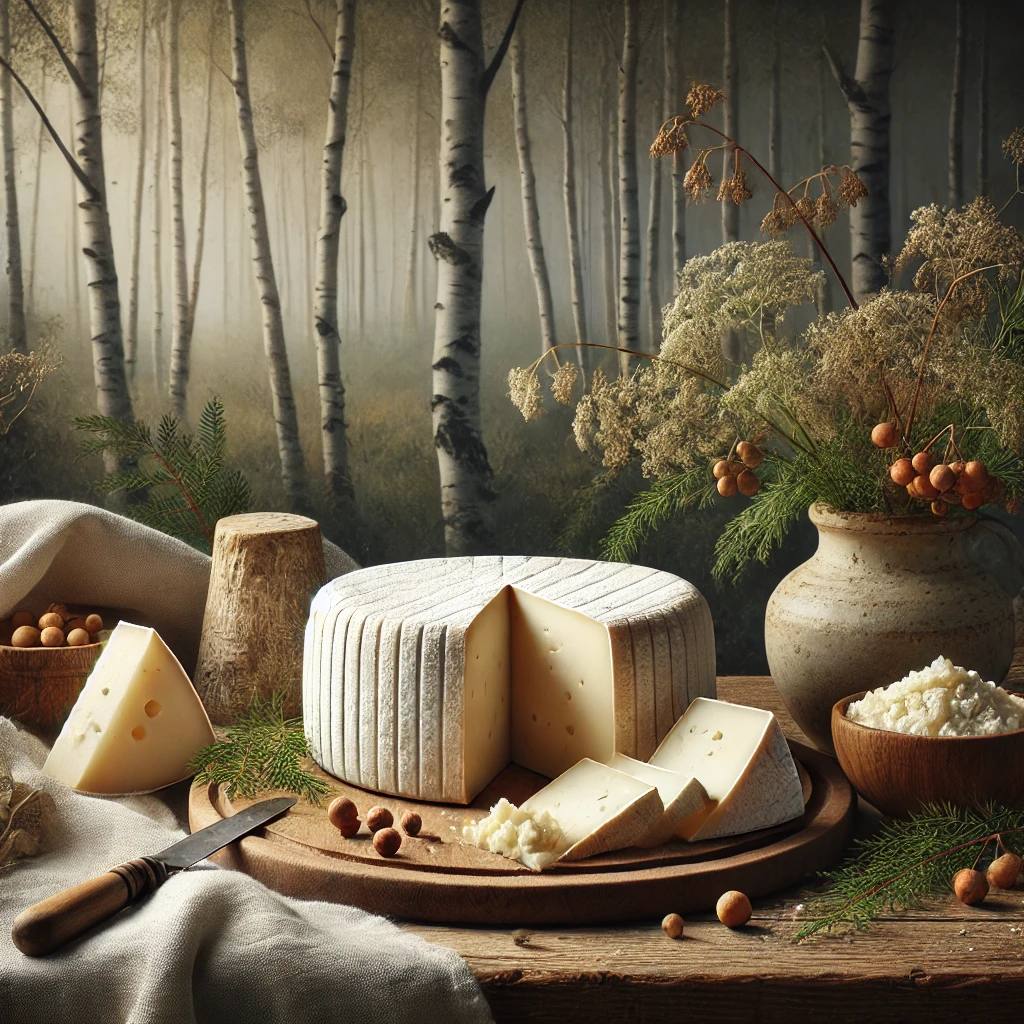When it comes to uniqueness and sophistication in the world of cheese, Moose Cheese genuinely stands out. Also known as ‘Älgost,’ this cheese is a rare culinary delight hailing from the northern regions of Sweden, crafted exclusively by the Johansson family at their Moose House. Unlike cow, sheep, or goat cheese, Moose Cheese is produced from the milk of three domesticated moose named Gullan, Haelga, and Juna.
Moose Cheese is highly valued due to its rarity and the meticulous production process it involves. For starters, the moose aren’t milked year-round, only from May to September when the moose are in lactation. The milking process itself is quite gentle and done manually, thereby producing a minimal yield of approximately 300 kilograms of cheese annually. Its limited production adds to the exclusivity and excitement around Moose Cheese, making it one of the most expensive cheeses globally, with prices ranging around 500 to 1,000 USD per kilogram.
- The flavour profile of Moose Cheese is distinct and luxurious. It tastes soft, supple with a slight tanginess, exhibiting the refined complexities of a high-quality cheese. It is often described as buttery and earthy, with a subtle hint of sweet grasses and wildflowers, reflecting the rich, green diet of the moose.
- Moose Cheese is extremely versatile and can be served as a gourmet treat on a cheese platter, incorporated into sophisticated culinary creations, or simply enjoyed on its own with a glass of wine.
- Interestingly, the Moose House also produces other exclusive dairy products like fudge, moose cheese with white mold, and blue cheese, alongside the traditional moose cheese. All these products resonate with the same luxuriousness and rarity that Älgost signifies.
A true luxury in the cheese aficionados’ world, Moose Cheese is an unparalleled gastronomic experience. Its rarity, intricate production process, unique taste, and versatility make it undoubtedly stand out. Thus, the intricacies of Älgost go beyond being just a cheese, representing a grand symbol of the exquisite richness that culinary products can achieve when intertwined with nature and meticulous craftsmanship.
Welcome to our quiz on the topic of ‘Moose Cheese from Sweden’! Discover how well you know this unique and rare delicacy. Are you ready to test your knowledge and learn something new about this Swedish gem? Let’s start!
Unveiling the Mystique of Moose Cheese: Ingredients, Properties and Varieties
Regarded as one of the rarest cheeses globally, Moose cheese originates in the northern climes of Sweden from a trio of milk-yielding Moose sisters – Gullan, Haelga, and Juno. Much like the elusive animal it comes from, Moose cheese’s rarity and unique properties account for its bewitching charm and considerably high price tag. Manufactured only in the summer months, when the Moose sisters yield milk, approximately 300 kilograms of this mesmerizing cheese is produced annually.
The elements that compose Moose cheese contribute to its uniqueness and gourmet prestige. The base of this exotic cheese is entirely raw Moose milk, obtained during a sensitive milking window of about 120 days. This period commences from May until September, following the calving of the Moose. The milk boasts a rich fat content of about 12%, almost twice as much as cow’s milk, and contains about 10% proteins, contributing to the cheese’s distinctively rich and creamy character.
- Traditional Plain Moose Cheese: This is the original Moose cheese, known for its white color, similar to a feta cheese, with a creamy, slightly nutty taste, and a texture that could best be compared to that of a young Gouda. Its lustrous sheen and delightful consistency make it a delightful gourmet experience.
- Cream Moose Cheese: A step beyond the plain version is the cream Moose cheese. This variety is known for its ultra-silky texture and lightness. It’s often used graciously on crackers, bread, or garnish on top of gourmet dishes.
- Aged Moose Cheese: This variety is ripened and matured for longer periods to intensify its flavors. The result is a robust, earthier profile with a pronounced depth and complexity. Its texture is firmer, often crumbled on salads or incorporated into sophisticated culinary dishes.
Whichever form it takes, Moose cheese carries an air of gastronomic mystery and sophistication and commands price tags as towering as the creature from which it hails. It embodies a culinary exploitation of the northern wilderness, and a testament to the intriguing versatility of cheese, from its creation process echoing the rhythm of nature to the rich, diversified tastes it presents to the global food connoisseur.
Moose Cheese: A Unique Delicacy from Sweden

Sweden, a country known for its stunning landscapes, rich history, and innovative culture, is also the home of a truly unique delicacy – Moose Cheese. Hailing from the pristine countryside of Bjurholm, a small village in northern Sweden, Moose Cheese is a rare and sought-after cheese made from the milk of moose cows.
The production of Moose Cheese is a labor-intensive process, requiring expert craftsmanship and a deep understanding of the moose’s biology and behavior. The moose cows are free-roaming and graze on wild and organic vegetation, resulting in milk that is distinct in flavor and composition.
One of the key factors that makes Moose Cheese exceptional is its limited availability. The milk yield of moose cows is considerably lower than that of traditional dairy cows, making Moose Cheese a truly exclusive treat. This limited production adds to the allure and desirability of this exquisite cheese.
Moose Cheese is renowned for its rich, creamy texture and earthy, nutty flavor. It pairs exceptionally well with robust wines and is often enjoyed on its own or as part of a cheese platter accompanied by fruit and crackers.
- Made from the milk of moose cows
- Produced in Bjurholm, Sweden
- Limited availability due to low milk yield
- Renowned for its rich, creamy texture and nutty flavor
- Sweden is home to roughly 400,000 moose during the summer.
- The production of moose cheese is extremely limited, with only about 300 kilograms being made annually.
- Apart from cheese, moose milk is also used to make ice cream and fudge.
- A kilogram of moose cheese can sell for up to $500.
- The three moose – Gullan, Haelga and Juno – produce milk only between May and September.
- Sweden’s ‘Moose House’ has become a tourist attraction due to cheese production.
- The yield of moose milk is significantly less than cow milk, contributing to the cheese’s high cost.
Mystic Delights of Moose Cheese: Unveiling Unexpected Recipes
Delicately subtle with an irreplaceable creamy texture, moose cheese is a surprising component with a touch of the unusual exotic. Primarily produced in Sweden, moose cheese is a royal delicacy due to its labor-intensive and limited production, as a fully grown moose produces just about five liters of milk per day. Unleashing the full range of this cheese’s potential, we invite you to indulge in two enchanting recipes, marrying the incomparable moose cheese with traditional and innovative culinary compositions.
1. Moose Cheese Crusted Salmon
Elegant simplicity wrapped in the embodied harmony of salmon and cheese, this recipe serves as a unique seafood entrée to awaken your senses.
- Ingredients: 4 salmon fillets, 1 cup finely grated moose cheese, 2 tbsp olive oil, salt, pepper, and dill to taste.
- Procedure: Preheat your oven to 375°F (190°C). Place the salmon fillets skin-down on a lined baking sheet, brush with olive oil, and sprinkle with sea salt, fresh ground pepper, and dill. Create a crust by liberally spreading the grated moose cheese over the fillets. Bake for 15-20 minutes until the cheese is golden brown and salmon is cooked through. Garnish with more dill and serve immediately.
2. Moose Cheese and Fig Jam Crostini
A beautiful mingling of flavors nestled on a toasted crostini, this recipe takes moose cheese and pairs it with the sweetness of fig jam, producing an irresistible appetizer for any occasion.
- Ingredients: Sliced baguette, 200g moose cheese, 1 jar of fig jam, fresh rosemary for garnish.
- Procedure: Preheat your oven to 350°F (180°C). Arrange the baguette slices on a baking sheet and toast for about 10 minutes, or until crisp and light golden brown. Butter each slice with a generous amount of fig jam, top with a slice of moose cheese. Return the tray to the oven until cheese is warm and slightly melted. Sprinkle with fresh rosemary before serving.
The magic of moose cheese lies in its tangy yet sweet undertones, its invaluable rarity, and the gastronomical sophistication it brings to these dishes. Whether you desire a bold, sensual seafood entrée or a sweet, sophisticated appetizer, these recipes offer a delightful showcase for moose cheese’s decadent character.
Decoding the Delectable Pairings for the Elite Moose Cheese
Famed for its rarity and exorbitant price tag, Moose Cheese positions itself on the top-tier of the unique and lavish dairy delicacies. Procured exclusively from a tiny dairy farm in Bjurholm, Sweden, this cheese is a creation of three domesticated female moose: Gullan, Haelga and Juna. With their lactation period limited to a few months a year, the cheese-making process is indulged in only between the months of May and September, thus attributing to its scarceness. Not merely limited to its rarity, Moose Cheese is cherished for its exquisite texture and refined flavors which are often likened to feta, albeit with more creaminess and tanginess. It’s this distinct profile of flavors and texture that makes it particularly interesting to explore wine and food pairings that enhance the delightful character of this unusual cheese.
The high fat content and rich, robust flavors of Moose Cheese pair beautifully with wines that can balance this richness with their acidity and fruit forwardness. Following are our top suggestions:
- Cabernet Sauvignon: This full-bodied red wine with ripe fruit aromas, and pronounced tannins, potentially compliments the creaminess of the Moose Cheese. It’s recommended to try a slightly aged Cabernet Sauvignon which would have the benefit of more mellow tannins.
- Riesling: When teamed with a fruity, crisp white wine like Riesling, the Moose Cheese’s complexity comes to the fore. Particularly, dry Rieslings with their high acidity and pronounced mineral character works best with the creaminess of the cheese.
- Champagne: A vibrant and bubbly Champagne or other sparkling wine not only cuts through the richness of the cheese but also heightens its nuanced flavors, making it an excellent celebratory pairing option.
When it comes to food pairings, Moose Cheese’s versatility shines bright. It perfectly complements dishes that carry a hint of sweetness, for example, it could be sprinkled over a fresh fig salad or paired with honey-roasted walnuts. For a delectable appetizer, try serving it with slices of crisp, tart green apple. The cheese also spectacularly enhances the richness of dishes like baked pasta or risotto. Further indulgence can be pursued by drizzling it over roasted vegetables or incorporating it within gourmet sandwiches.
Delicious Alternatives: Similar Cheeses to Moose Cheese
Moose cheese is a rare and highly sought-after delicacy, known for its unique flavor and creamy texture. However, due to its limited availability and high cost, you may be wondering if there are any alternatives that can provide a similar taste experience. While it’s hard to replicate the exact flavor of moose cheese, there are a few cheeses in the market that share some similarities and can be enjoyed as substitutes or alternatives. Let’s explore some delicious options that can satisfy your cheese cravings:
1. Reindeer Cheese: Like moose cheese, reindeer cheese is made from the milk of reindeer. It has a rich and slightly gamey flavor, with a creamy and velvety texture. This cheese is produced mainly in Scandinavian countries, particularly in Sweden and Norway, where reindeer herding is a traditional way of life. Reindeer cheese is often enjoyed with lingonberry jam or as a topping for open sandwiches, known as smørrebrød.
2. Sheep Cheese: Another excellent alternative to moose cheese is sheep cheese. Sheep milk cheese can vary in flavor depending on the region and the breed of sheep, but generally, it has a rich and robust taste with a creamy texture. Some popular sheep cheeses include Pecorino Romano from Italy, Roquefort from France, and Manchego from Spain. These cheeses offer a distinct flavor profile and can be enjoyed on their own or incorporated into various dishes, such as salads, pasta, or grilled cheese sandwiches.
3. Goat Cheese: If you’re looking for a cheese with a similar tangy and earthy flavor to moose cheese, goat cheese is an excellent choice. Goat cheese comes in a variety of styles, ranging from soft and spreadable to firm and crumbly. It has a distinctive tartness and can have herbal or citrusy notes, depending on the specific type. Goat cheese pairs well with fruits, honey, and nuts, making it a versatile option for both sweet and savory culinary creations.
While these cheeses might not be identical to moose cheese, they do offer unique flavors and textures that can be enjoyed by cheese lovers. Whether you opt for reindeer cheese, sheep cheese, or goat cheese, you’re sure to indulge in a delightful and satisfying cheese experience.
Summary:
- Moose cheese is a rare and sought-after delicacy known for its unique flavor and creamy texture.
- Reindeer cheese is made from the milk of reindeer and shares some similarities with moose cheese, including a rich and slightly gamey flavor.
- Sheep cheese, such as Pecorino Romano, Roquefort, or Manchego, offers a robust taste and creamy texture as an alternative to moose cheese.
- Goat cheese has a tangy and earthy flavor that can be enjoyed in various styles, from soft and spreadable to firm and crumbly.
- While these cheeses aren’t identical to moose cheese, they provide unique flavors and textures for cheese lovers to explore and enjoy.



